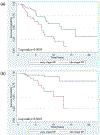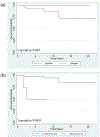Survival, disease progression and prognostic factors in elderly patients with mycosis fungoides and Sézary syndrome: a retrospective analysis of 174 patients
- PMID: 30176169
- PMCID: PMC6338490
- DOI: 10.1111/jdv.15236
Survival, disease progression and prognostic factors in elderly patients with mycosis fungoides and Sézary syndrome: a retrospective analysis of 174 patients
Abstract
Background: Advanced age at diagnosis is considered a poor prognostic factor in mycosis fungoides (MF) and Sézary syndrome (SS).
Objective: To evaluate the outcomes and prognostic factors in patients diagnosed at an advanced age (≥65 years) with MF/SS.
Methods: Survival, progression rates and various clinical and histopathological variables were studied in a group of 174 elderly patients diagnosed with MF/SS between 1992 and 2015 at a single referral cancer center in the United States. Kaplan-Meier estimates were used to determine survival and progression and Cox proportional hazards regression univariate and multivariate models were used to identify prognostic factors.
Results: Of 174 elderly patients, 76.4% were diagnosed with early-stage (clinical stages IA-IIA) and 23.6% with late-stage MF/SS (IIB-IV). Advanced age was associated with poor overall survival, but not with disease-specific survival (DSS) or progression-free survival (PFS). Gender, increasing clinical stage, T and B classifications, elevated lactate dehydrogenase (LDH) levels and development of large cell transformation (LCT) were significant predictors of poor survival or disease progression. Patients with early-stage MF and <10% total skin involvement (T1 classification) or patch-only disease (T1a/T2a) showed better PFS with no observed disease-specific mortality. Folliculotropic MF was associated with poor DSS in patients with early-stage disease.
Conclusions: Older age at diagnosis of MF/SS does not predict worse disease-specific outcomes. Elderly patients with early-stage disease, specifically involving less than 10% of the skin surface with patches but without plaques or folliculotropism, have an excellent prognosis. However, the development of LCT is a strong prognostic indicator of poor survival in elderly patients with MF/SS.
© 2018 European Academy of Dermatology and Venereology.
Conflict of interest statement
Figures


Similar articles
-
Survival outcomes and prognostic factors in mycosis fungoides/Sézary syndrome: validation of the revised International Society for Cutaneous Lymphomas/European Organisation for Research and Treatment of Cancer staging proposal.J Clin Oncol. 2010 Nov 1;28(31):4730-9. doi: 10.1200/JCO.2009.27.7665. Epub 2010 Sep 20. J Clin Oncol. 2010. PMID: 20855822
-
Cutaneous Lymphoma International Consortium Study of Outcome in Advanced Stages of Mycosis Fungoides and Sézary Syndrome: Effect of Specific Prognostic Markers on Survival and Development of a Prognostic Model.J Clin Oncol. 2015 Nov 10;33(32):3766-73. doi: 10.1200/JCO.2015.61.7142. Epub 2015 Oct 5. J Clin Oncol. 2015. PMID: 26438120 Free PMC article.
-
Advanced-stage mycosis fungoides and Sézary syndrome: survival and response to treatment.Clin Lymphoma Myeloma Leuk. 2015 Jun;15(6):e105-12. doi: 10.1016/j.clml.2015.02.027. Epub 2015 Mar 5. Clin Lymphoma Myeloma Leuk. 2015. PMID: 25817937
-
Prognostic factors, prognostic indices and staging in mycosis fungoides and Sézary syndrome: where are we now?Br J Dermatol. 2014 Jun;170(6):1226-36. doi: 10.1111/bjd.12909. Br J Dermatol. 2014. PMID: 24641480 Review.
-
Primary cutaneous T-cell lymphoma (mycosis fungoides and Sézary syndrome): part II. Prognosis, management, and future directions.J Am Acad Dermatol. 2014 Feb;70(2):223.e1-17; quiz 240-2. doi: 10.1016/j.jaad.2013.08.033. J Am Acad Dermatol. 2014. PMID: 24438970 Review.
Cited by
-
Epidemiology and prognostic factors of 114 patients with mycosis fungoides in a Moroccan cohort: a 29-year review.Clin Exp Med. 2023 Nov;23(7):3751-3758. doi: 10.1007/s10238-023-01056-7. Epub 2023 Apr 8. Clin Exp Med. 2023. PMID: 37029872
-
Outcomes and prognostic factors in African American and black patients with mycosis fungoides/Sézary syndrome: Retrospective analysis of 157 patients from a referral cancer center.J Am Acad Dermatol. 2020 Aug;83(2):430-439. doi: 10.1016/j.jaad.2019.08.073. Epub 2019 Sep 6. J Am Acad Dermatol. 2020. PMID: 31499157 Free PMC article.
-
Staging lymph nodes and blood at diagnosis in mycosis fungoides identifies patients at increased risk of progression to advanced stage: A retrospective cohort study.Cancer. 2023 Feb 15;129(4):541-550. doi: 10.1002/cncr.34579. Epub 2022 Dec 15. Cancer. 2023. PMID: 36523150 Free PMC article.
-
Mimicry unveiled: The challenging diagnosis of pigmented purpura-like mycosis fungoides initially misdiagnosed as pigmented purpura.Clin Case Rep. 2024 May 20;12(5):e8847. doi: 10.1002/ccr3.8847. eCollection 2024 May. Clin Case Rep. 2024. PMID: 38770416 Free PMC article.
-
GATA3 as a Prognostic Marker in Early-Stage Classical Mycosis Fungoides: Association With Disease Progression and Survival Outcomes.Cancer Med. 2025 Sep;14(17):e71151. doi: 10.1002/cam4.71151. Cancer Med. 2025. PMID: 40856420 Free PMC article.
References
-
- Korgavkar K, Xiong M, Weinstock M. Changing incidence trends of cutaneous T-cell lymphoma. JAMA Dermatol 2013; 149: 1295–9. - PubMed
-
- Jawed SI, Myskowski PL, Horwitz S et al. Primary cutaneous T-cell lymphoma (mycosis fungoides and Sezary syndrome): part I. Diagnosis: clinical and histopathologic features and new molecular and biologic markers. J Am Acad Dermatol 2014; 70: 205.e1–16; quiz 21–2. - PubMed
-
- Imam MH, Shenoy PJ, Flowers CR et al. Incidence and survival patterns of cutaneous T-cell lymphomas in the United States. Leuk Lymphoma 2013; 54: 752–9. - PubMed
-
- Crowley JJ, Nikko A, Varghese A et al. Mycosis fungoides in young patients: clinical characteristics and outcome. J Am Acad Dermatol 1998; 38: 696–701. - PubMed
-
- Weinstock MA, Reynes JF. The changing survival of patients with mycosis fungoides: a population-based assessment of trends in the United States. Cancer 1999; 85: 208–12. - PubMed
MeSH terms
Substances
Grants and funding
LinkOut - more resources
Full Text Sources
Other Literature Sources
Medical

